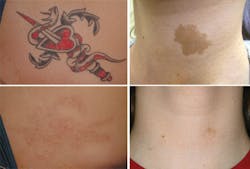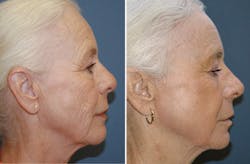PHOTONICS APPLIED: AESTHETIC PHOTONICS: Looking good with lasers
In addition to the internal healing functions of low-level light therapy (LLLT), light-based products are also helping people look good on the outside. Aesthetic photonics—light sources and optical beam-delivery systems used for wrinkle and hair removal, laser-assisted in situ keratomileusis or LASIK eye surgery, and laser liposuction just to name a few—are part of a growing aesthetic medical device business that reached $1.8 billion in 2009 and is forecast to reach nearly $3 billion by 2016 at a 7% compound annual growth rate.1,2
Research and development into aesthetic light treatments is a healthy and ongoing business—especially when the potential customer base (and associated financial payoff) is huge. Just in late August 2011, researchers at the University of Michigan (Ann Arbor) used a 1708 nm telecom laser to treat acne by targeting oil-producing sebaceous glands responsible for acne flares. The laser melts fat without affecting surrounding tissue and can penetrate skin to a depth of 1.5 mm. Finally, Proactiv has a potential competitor that uses light rather than chemicals!
But aesthetic photonics is not just an academic exercise; commercially available light-based beauty technologies are now part of mainstream media advertisements and infomercials, and are beginning to challenge sales of conventional beauty products. If you haven’t seen it yet, there is an e-mail on laser hair removal from American Laser Skincare (Farmington Hills, MI) in your future.
On the surface
Wrinkles, hair in unwanted places, and skin blemishes are definitely three major foes for appearance-conscious individuals. Fortunately, laser alternatives for these and related surface “conditions” are now available in most professional spa settings, with handheld in-home products making headway in the market. Although these treatments are still more expensive in terms of initial capital investment than conventional topical creams and peels, shaving, and waxing, published case studies reveal that light-based treatments really work and the positive effects can last months and years compared to traditional treatments.
In late 2009, Syneron Medical (Yokneam, Israel) and Candela Corp. (Wayland, MA) merged to create one of the largest aesthetic medical device companies, with a 41% global market share and on target to reach $208 million in sales for 2011. Their products use laser, laser diode, and LED sources—as well as non-photonic radio frequency (RF) and ultrasound techniques—for hair and wrinkle (and acne) removal, skin rejuvenation (and whitening and tightening), cellulite reduction, teeth whitening (estimated as a $5.5 billion dollar global market alone), vascular and pigment lesion removal, and tattoo removal.
At the American Society for Laser Medicine and Surgery (ASLMS) 2009 meeting, Syneron/Candela aesthetic light-based products were the subject of more than 14 presentations. In one paper, the Alex TriVantage laser was shown to effectively remove skin lesions and tattoos (see Fig. 1).3 Improving on the decades-long use of individual Q-switched ruby, Nd:YAG, and alexandrite lasers for tattoo removal, the Alex TriVantage delivers three individual wavelengths of light at 532, 755, and 1064 nm with nanosecond-domain pulses to target multicolored tattoo ink pigment granules buried in dermal fibroblast bundles (connective tissue in the skin). In general, 532 nm light removes red ink, 755 nm light removes green ink, and 1064 nm longer-wavelength infrared light—which is not absorbed by melanin as much as shorter wavelengths—removes black ink with minimal effect on pigment in surrounding tissues.
Alex TriVantage is a Q-switched alexandrite (755 nm) laser coupled to a 1.5-mm-diameter silica optical fiber with homogenizers to achieve a collimated, top-hat energy distribution for the treatment spot. Additional lensed handpieces perform both wavelength conversion and adjust the beam spot size from 2–5 mm. In one handpiece, a 20-mm-long Nd:YAG crystal converts the alexandrite beam to a 1064 nm output with 60% efficiency, while another handpiece adds a potassium titanyl phosphate (KTP) nonlinear crystal to frequency-double 1064 nm light to 532 nm light. Simply exchanging the handpieces allows patient treatment using 532, 755, and 1064 nm wavelengths for permanent tattoo removal.
Three papers by Elizabeth VanderVeer, internist and medical director of the VanderVeer Center (Portland, OR), describe how the Syneron/Candela GentleYAG—a 50 mJ/cm2 Nd:YAG laser with 50 ms pulse duration at 2 Hz—can visibly tighten skin (and even perform a “breast lift”) by stimulating collagen production in the dermis.
And finally, several papers describe treatment of port wine stains and periorbital dark circles using the Syneron/Candela VBeam Perfecta 595 nm pulsed dye laser (treatment parameters 0.5–10 ms pulses at 6–8 J/cm2 fluence), which efficiently targets hemoglobin in the blood and collapses the proliferating blood vessels underlying these conditions.
The Mayo Clinic (Rochester, MN) says that laser-based acne treatments use either blue light to target the Propionibacterium acnes (P. acnes) bacteria that causes acne inflammation, or a long-wavelength infrared laser to heat and shrink/destroy oil-producing sebaceous glands deep in the dermis.4 Syneron/Candela conducted a study that showed a 57% reduction in acne lesions after five treatments (one month apart) by a large-spot size (10–12 mm), 7–9 J/cm2 fluence, 1450 nm laser diode. Better still, reduced lesion counts were maintained six months after the treatments ended.
For hair removal, products span the spectrum from in-office or in-spa laser devices (see a list of manufacturers at www.hairremovalforum.com/manufacturers.htm) to the only FDA-approved, in-home, handheld device from TRIA Beauty (Dublin, CA) for $395.
A case study by Lumenis (Yokneam, Israel) on its LightSheer 800 nm laser-diode hair removal product said that it removed hair successfully for 95% of the 800 treatments performed on 250 skin sites in 144 patients.5 Skin color is important since the laser targets melanin—the same pigment in skin responsible for skin coloration. In the selective photothermolysis process, lasers in the 600–1100 nm range heat and destroy melanin in the hair shaft and the hair follicle epithelium. If melanin absorption and laser heating is too high for regions beyond the hair shaft, skin can be damaged in the hair-removal process; in general, the process works best for light-skinned people with dark hair.
LightSheer is effective for hair removal because melanin in the hair follicle absorbs three to four times more energy at 800 nm than at 1064 nm Nd:YAG laser wavelengths. Pulsewidth durations for LightSheer are typically 30–100 ms depending on hair type and coloration (longer pulses for darker skin), with fluence levels between 25 and 29 J/cm2. The device even has an actively cooled convex sapphire lens called ChillTip that is pressed to the patient’s skin before and during treatment, flattening the skin to better isolate the hair follicles and cooling the epidermis for skin protection. A small number of treatments—two to four—are typically spaced at four- to eight-week intervals when hair is in the growth phase. While hair removal is seldom permanent, treatment at proper intervals can reduce the number of hair follicles and size of the regrown hair shaft.
Though the aesthetic market really sprouted with the invention of carbon-dioxide (CO2) laser skin resurfacing in the 1990s, the approach was quite invasive—ablating the complete epidermis down into the dermis. In 2008 Lumenis launched the DeepFX ablative fractional skin-resurfacing approach, giving the physician the ability to control the treated areas and determine whether coagulation is superficial or deep. With patient downtime typically less than one week, this approach—called UltraPulse—uses a Coherent (Santa Clara, CA) CO2 RF-excited slab laser technology that provides the highest energy in the shortest amount of time of all available CO2 lasers in the medical device market. In addition to aesthetic skin resurfacing, a more compelling application is the resurfacing of mature, scarred, or burned skin, whereby UltraPulse leads to more normal skin regeneration, restoring skin texture and pliability (see Fig. 2).6The Smartlipo output beam is delivered by a 300-, 600-, or 1000-µm-core-diameter optical fiber in a SmartSense handpiece that stops firing if the handpiece stops moving. And a temperature sensor in the laser cannula (small insertion tube) called ThermaGuide turns the laser off if unsafe tissue temperatures are reached. “Cynosure was the first to offer multiplexed and intelligent delivery systems on a laser lipolysis platform,” says Karen Cronholm, Cynosure senior product manager. “Multiplexing—the ability to fire two wavelengths sequentially—provides the doctor with the best of both wavelengths at once. The intelligent delivery systems [SmartSense and ThermaGuide] ensure patient safety by providing accurate control.”
While surgical holmium YAG, 532 nm diode-pumped solid-state (DPSS) lasers, and laser diodes are used for ablative surgery to reduce benign prostatic hyperplasia (BPH), vaporize bladder tumors, and remove enlarged tonsils in humans, CO2 lasers are being used in veterinary and human soft-tissue applications to replace steel scalpels in general surgery.
“For more than three decades the CO2 laser remains the gold standard of surgical lasers thanks to the high absorption rate of its wavelength in soft tissues with high water content,” says Peter Vitruk, CEO at Luxarcare-Aesculight LLC (Woodinville, WA). Like the LASIK flap cut in the cornea using a femtosecond pulse laser, the tiniest and least invasive skin cuts are desired by plastic surgeons to minimize scarring. And yet, despite talking to several surgical laser manufacturers and researching “lasers in cosmetic surgery” online, little evidence could be found that lasers are being widely pursued for making delicate skin cuts.
As to why, some experts cite the fact that lasers cost much more than conventional scalpels and cannot give surgeons the same tactile feedback as a physical scalpel. An exception to this rule is blepharoplasty—surgical modification of the eyelid commonly known as an eyelid “lift” to remove sagging and fatty tissue. A majority of these blepharoplasty procedures are for cosmetic rather than medical purposes and CO2 lasers are widely used, in part due to the laser’s ability to coagulate blood and expedite healing. For a surgeon’s opinion, see http://www.youtube.com/watch?v=7R275OD4PEk.
REFERENCES
1. www.news-medical.net/news/20100204/Global-medical-aesthetic-devices-market-to-reach-2429-billion-in-2016.aspx
2. www.brocair.com/downloads/AestheticMedicalDeviceMarket_Feb2009.pdf
3. E.F. Bernstein et al., J. Drugs in Dermatology, 9, 11, 1333–1339 (November 2010).
4. www.mayoclinic.com/health/acne-treatments/SN00038
5. www.aesthetic.lumenis.com/pdf/safety_efficacy.pdf
6. D. Ozog et al., ASLMS 2011, paper 54, Grapevine, TX (March 30–April 3, 2011).
About the Author

Gail Overton
Senior Editor (2004-2020)
Gail has more than 30 years of engineering, marketing, product management, and editorial experience in the photonics and optical communications industry. Before joining the staff at Laser Focus World in 2004, she held many product management and product marketing roles in the fiber-optics industry, most notably at Hughes (El Segundo, CA), GTE Labs (Waltham, MA), Corning (Corning, NY), Photon Kinetics (Beaverton, OR), and Newport Corporation (Irvine, CA). During her marketing career, Gail published articles in WDM Solutions and Sensors magazine and traveled internationally to conduct product and sales training. Gail received her BS degree in physics, with an emphasis in optics, from San Diego State University in San Diego, CA in May 1986.

